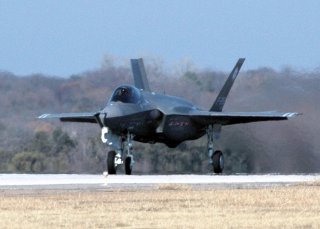Japan's Next-Generation Stealth Fighter Could be a Game-Changer
Might the advent of new stealth fighters better position Japan’s military for the possibility of offensive operations in the region, should that become necessary? Recognizing the Japanese constitution and the longstanding restraints placed upon them, requiring them to operate purely “defensive” forces, perhaps the current threat environment and Japan’s growing alliance with the U.S. might impact this in some way.
Here's What You Need To Remember: Could Japan be accelerating its effort to further strengthen its technical ability to operate alongside U.S. aircraft? It certainly seems entirely possible as both countries seek to greatly strengthen a deterrence posture against China in both in the region and globally.
Japan is taking new steps to engineer an advanced, next-generation fighter jet to emerge in the 2030s, raising some interesting questions about the kinds of technologies it is likely to incorporate.
A report from the Associated Press states that Japan has picked Mitsubishi Heavy Industries to develop a next-generation stealth fighter, an initiative likely to improve Japan’s strategic position in the region and add new tactical possibilities to the Japanese Air Self Defense Force.
The report says the new stealth fighter will replace Japan’s legacy F-2 fighter and fly alongside a growing fleet of F-35s. Japan operates roughly 290 aircraft and is now acquiring dozens of F-35s to replace its F-4 fighters.
Clearly, the move appears to be in response to Chinese and North Korean threats and also seems to strengthen Japan’s ability to support the U.S. as a key regional ally. The United States and Japan are already up ticking a large number of F-35-oriented joint training exercises and combined operations to show solidarity in the region and deter Chinese activities. Chinese fighters are well known for making provocative maneuvers to operate near the Japanese coastline, causing Japan to scramble in response.
Another interesting element of this can be viewed through the lens of recent U.S. success in flying a 6th Generation stealth aircraft prototype. Could Japan be accelerating its effort to further strengthen its technical ability to operate alongside U.S. aircraft? It certainly seems entirely possible as both countries seek to greatly strengthen a deterrence posture against China in both in the region and globally.
Also, given that Japan is well known for its technological sophistication, it seems entirely possible that its ability to engineer next-generation camera technology, computers and avionics, the country may well be positioned to build a 6th-gen fighter with new levels of performance abilities. Japan would also be well-positioned to engineer an advanced aircraft able to network with F-35s and even U.S. 6th-gen aircraft given the growing emphasis upon combat networking.
The strategic concept that air attack platforms will increasingly function as “nodes” within a combat network to share combat-relevant warzone data and also operate as offensive systems, offers a circumstance which Japan may be well-positioned to leverage. Extensive networking, radio technology, electronic warfare, and the kinds of electronic connectivity of great relevance to warzone avionics is something Japan is quite well-suited to pursue.
As a broader question, might the advent of new stealth fighters better position Japan’s military for the possibility of offensive operations in the region, should that become necessary. Recognizing the Japanese constitution and the longstanding restraints placed upon them, requiring them to operate purely “defensive” forces, perhaps the current threat environment and Japan’s growing alliance with the U.S. might impact this in some way.
Clearly, Japan does not seem likely to invade or launch offensive attacks, and any advanced systems would clearly be useful for deterrence and defensive purposes, yet strengthening combat capability in this way does seem to introduce an interesting possibility. Would it be beyond the realm for the Japanese military to operate under somewhat different or slightly revised strategic circumstances? Perhaps this might strengthen its position as a deterrent, should it be allowed to at least present a threat of offensive attack? After all, isn’t the presence of countervailing power and the threat of some kind of attack a key basis for the kind of deterrence strategy needed to keep the peace?
Kris Osborn is the defense editor for the National Interest. Osborn previously served at the Pentagon as a Highly Qualified Expert with the Office of the Assistant Secretary of the Army—Acquisition, Logistics & Technology. Osborn has also worked as an anchor and on-air military specialist at national TV networks. He has appeared as a guest military expert on Fox News, MSNBC, The Military Channel, and The History Channel. He also has a Masters Degree in Comparative Literature from Columbia University. This article was originally published earlier this month.
Image: Reuters.

